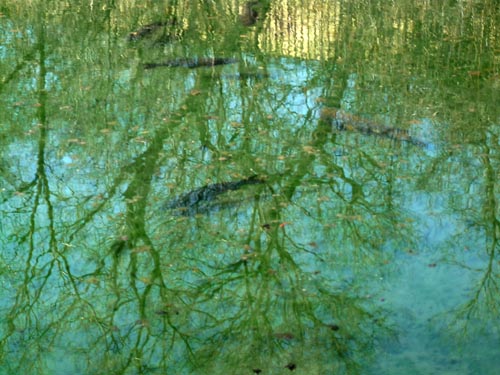Contrary to an earlier finding by a federal agency, state officials assert that Coldwater Spring meets the criteria for listing on the National Register of Historic Places as a Traditional Cultural Property (TCP). The Minnesota State Historic Preservation Office (MNSHPO) in St. Paul, has put on record its agreement with a June 2006 report by a cultural resources consultant supporting the eligibility of Coldwater as a TCP for Dakota people. MNSHPO has informed officials at the Mississippi National River and Recreation Area (MNRRA), the local St. Paul branch of the National Park Service, that MNSHPO does not concur with the decision of MNRRA, in 2006, to reject the finding of the consultant about the Dakota importance of the spring.
Coldwater Spring basin
In a letter of April 14, 2010, Britta Bloomberg, Deputy State Historic Preservation Officer, informed MNRRA of MNSHPO’s determination. The letter was written as a cover letter to the signed Memorandum of Agreement (MOA) involving actions to be taken during the removal of buildings on the Coldwater/ Bureau of Mines Twin Cities Campus property. (The letter and MOA are available here as a pdf.) On the issue of the status of Coldwater Spring as a TCP, Bloomberg voiced the independent judgment of the state agency, expressing some of the same surprise that others felt about the decision by MNRRA in 2006. Bloomberg stated:
While the MOA is silent on the matter, we wish to put on record our opinion that Coldwater Spring meets the criteria for listing in the National Register of Historic Places as a Traditional Cultural Property (TCP). Our staff has reviewed the ethnographic resources study prepared by your cultural resources consultant (June 2006) and are in agreement with their findings that the site does qualify as a TCP. We were surprised that the National Park Service has disagreed with this determination. We will be happy to discuss our reasoning. We want to be clear that signing the MOA in no way implies that we concur with the National Park Service’s opinion on this matter. We fully expect to revisit this discussion during the separate Section 106 process referenced in Stipulation II.C. of the MOA that will be undertaken before determining the final treatment plan for Coldwater Spring.
The MNSHPO is a program within the Minnesota Historical Society though it carries on functions funded through the federal government and has a role in processes such as the so-called Section 106 process, which fulfills the requirement that federal agencies take into account the effect of their actions on historic properties such as Coldwater. The MNSHPO however is an agency separate of federal agencies and provides an independent evaluation of federal decisions. Nina Archabal the director of the Minnesota Historical Society, is officially the State Historic Preservation Officer, but Deputy Director of MNSHPO Britta Bloomberg manages the program. While Archabal signed the MOA, Bloomberg signed the letter to MNRRA.
The effect of this rejection of the MNRRA decision on Coldwater Spring depends on how MNRRA–and John Anfinson, the historian in MNRRA who, according to the recently released “White Paper,” made the decision to reject the findings of the independent consultant–respond to SHPO’s letter. According to the “White Paper,” Anfinson’s decision in 2006 did not preclude further discussion. According to a message received from Britta Bloomberg, a discussion on the issue was held on May 20, 2010, with Anfinson “and that discussion continues.”
The disagreement with the MNSHPO also provides an opportunity for the wisdom of the MNRRA/ Anfinson 2006 decision to be re-examined within MNRRA and the Park Service and also by Anfinson himself. It is too soon to know if federal officials or Anfinson are taking advantage of this opportunity.
